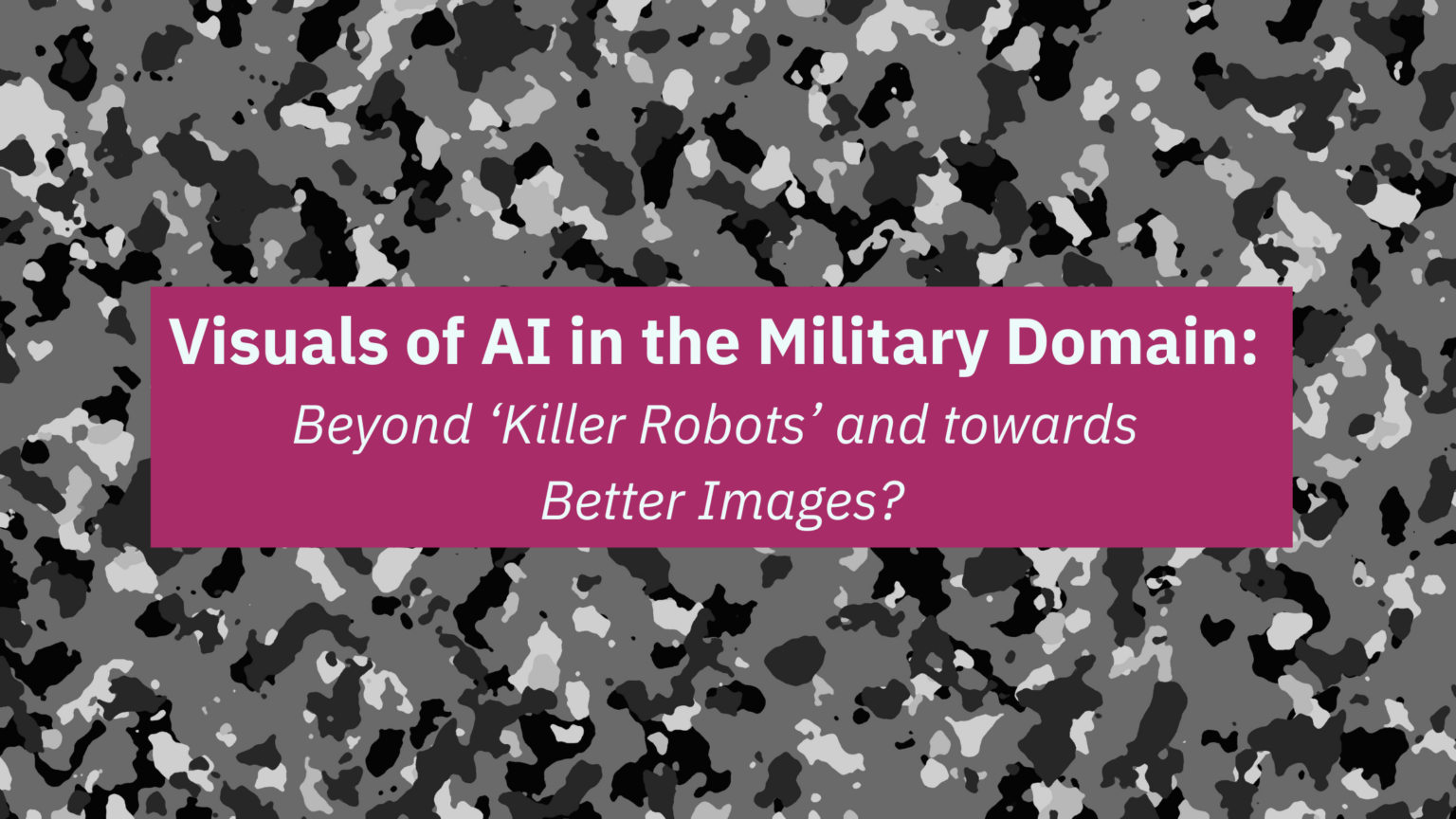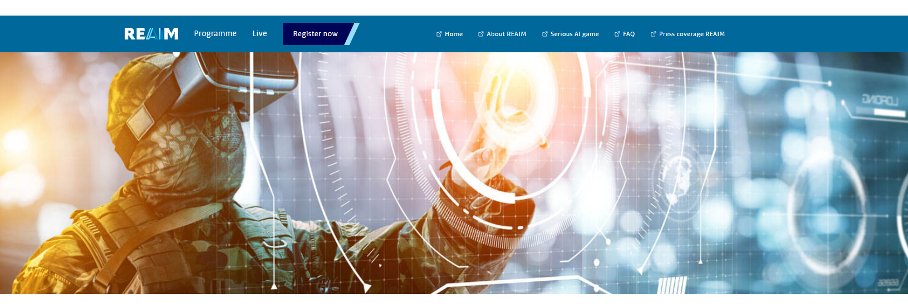
ΑΙhub.org
Visuals of AI in the military domain: beyond ‘killer robots’ and towards better images?

By Anna Nadibaidze
In this blog post, Anna Nadibaidze explores the main themes found across common visuals of AI in the military domain. Inspired by the work and mission of Better Images of AI, she argues for the need to discuss and find alternatives to images of humanoid ‘killer robots’. Anna holds a PhD in Political Science from the University of Southern Denmark (SDU) and is a researcher for the AutoNorms project, based at SDU.
The integration of artificial intelligence (AI) technologies into the military domain, especially weapon systems and the process of using force, has been the topic of international academic, policy, and regulatory debates for more than a decade. The visual aspect of these discussions, however, has not been analysed in depth. This is both puzzling, considering the role that images play in shaping parts of the discourses on AI in warfare, and potentially problematic, given that many of these visuals, as I explore below, misrepresent major issues at stake in the debate.
In this piece I provide an overview of the main themes that one may observe in visual communication in relation to AI in international security and warfare, discuss why some of these visuals raise concerns, and argue for the need to engage in more critical reflections about the types of imagery used by various actors in the debate on AI in the military.
This blog post is based on research conducted as part of the European Research Council funded project “Weaponised Artificial Intelligence, Norms, and Order” (AutoNorms), which examines how the development and use of weaponised AI technologies may affect international norms, defined as understandings of ‘appropriateness’. Following the broader framework of the project, I argue that certain visuals of AI in the military, by being (re)produced via research communication and media reporting, among others, have potential to shape (mis)perceptions of the issue.
Why reflecting upon images of AI in the military matters
As with the field of AI ethics more broadly, critical reflections on visual communication in relation to AI appear to be minimal in global discussions about autonomous weapon systems (AWS)—systems that can select and engage targets without human intervention—which have been ongoing for more than a decade. The same can be said for debates about responsible AI in the military domain, which have become more prominent in recent years (see, for instance, the initiative of the Responsible AI in the Military Domain Summit held first in 2023, with another edition due in 2024).
Yet, examining visuals deserves a place in the debate on responsible AI in the military domain. It matters because, as argued by Camila Leporace on this blog, images have a role in constructing certain perceptions, especially “in the midst of the technological hype”. As pointed out by Maggie Mustaklem from the Oxford Internet Institute, certain tropes in visual communication and reporting about AI disconnect the technological developments in that area and how people, in particular the broader public, understand what the technologies are about. This is partly why the AutoNorms project blog refrains from using the widely spread visual language of AI in the military context and uses images from the Better Images of AI library as much as possible.
Main themes and issues in visualizing military applications of AI
Many of the visuals featured in research communication, media reporting, and publications about AI in the military domain speak to the tropes and clichés in images of AI more broadly, as identified by the Better Images of AI guide.
One major theme is anthropomorphism, as we often see pictures of white or metallic humanoid robots that appear holding weapons, pressing nuclear buttons, or marching in troops like soldiers with angry or aggressive expressions, as if they could express emotions or be ‘conscious’ (see examples here and here).
In some variations, humanoids evoke associations with science fiction, especially the Terminator franchise. The Terminator is often referenced in debates about AWS, which feature in a substantial part of the research on AI in international relations, security, and military ethics. AWS are often called ‘killer robots’, both in academic publications and media platforms, which seems to encourage the use of images of humanoid ‘killer robots’ with red eyes, often originating from stock image databases (see examples here, here, and here). Some outlets do, however, note in captions that “killer robots do not look like this” (see here and here).
Actors such as campaigners might employ visuals, especially references from pop culture and sci-fi, to get people more engaged and as tools to “support education, engagement and advocacy”. For instance, Stop Killer Robots, a campaign for an international ban on AWS, often uses a robot mascot called David Wreckham to send their message that “not all robots are going to be as friendly as he is”.
Sci-fi also acts as a point of reference for policymakers, as evidenced, for example, by US official discourses and documents on AWS. As an illustration, some of these common tropes were visually present at the conference “Humanity at the Crossroads: Autonomous Weapons Systems and the Challenge of Regulation” which brought together diplomats, civil society, academia, and other actors to discuss the potential international regulation of AWS in April 2024 in Vienna.
 Half-human half-robot projected on the wall and a cut-out of a metallic robot greeting participants at the entrance of the Vienna AWS conference. Photos by Anna Nadibaidze.
Half-human half-robot projected on the wall and a cut-out of a metallic robot greeting participants at the entrance of the Vienna AWS conference. Photos by Anna Nadibaidze.
The colour blue also often features in visual communication about AI in warfare, together with abstract depictions of running code, algorithms, or computing technologies. This is particularly distinguishable in stock images used for blogs, conferences, or academic book cover designs. As Romele and Rodighiero write on this blog, blue might be used because it is calming, soothing, and also associated with peace, encouraging some accepting reaction from viewers, and in this way promoting certain imaginaries about AI technologies.
 Examples of covers for recently published academic books on the topic of AI in international security and warfare.
Examples of covers for recently published academic books on the topic of AI in international security and warfare.
There are further distinct themes in visuals used alongside publications about AI in warfare and AWS. A common trope features human soldiers in an abstract space, often with a blue (and therefore calming) background or running code, wearing a virtual reality headset and presumably looking at data (see examples here and here). One such visual was used for promotional material of the aforementioned REAIM Summit, organised by the Dutch Government in 2023.
 Screenshot of the REAIM Summit 2023 website homepage. The image is credited to the US Naval Information Warfare Center Pacific, public domain.
Screenshot of the REAIM Summit 2023 website homepage. The image is credited to the US Naval Information Warfare Center Pacific, public domain.
Finally, many images feature military platforms such as uncrewed aerial vehicles (UAVs or drones) flying alone or in swarms, robotic ground vehicles, or quadruped animal-shaped robots, either depicted alone or together with human soldiers. Many of them are prototypes or models of existing systems tested and used by the United States military, such as the MQ-9 Reaper (which does not classify as an AWS). Most often, these images are taken from the visual repository of the US Department of Defense, given that the photos released by the US government are in the public domain and therefore free to use with attribution (see examples here, here, and here). Many visuals also display generic imagery from the military, for instance soldiers looking at computer screens, sitting in a control room, or engaging in other activities (see examples here, here, and here).

Example of image often used to accompany online publications about AWS. Source: Cpl Rhita Daniel, US Marine Corps, public domain.
However, there are several issues associated with some of the common visuals explored above. As AI researcher and advocate for an AWS ban Stuart Russell points out, references to the Terminator or sci-fi are inappropriate for the debate on AI in the military because they suggest that this is a matter for the future, whereas the development and use of these technologies is already happening.
Sci-fi references and humanoids might also give the impression that AI in the military is about replacing humans with ‘conscious’ machines that will eventually fight ‘robot wars’. This is misleading because the debate surrounding the integration of AI into the military is mostly not about robots replacing humans. Armed forces around the world plan to use AI for a variety of purposes, especially as part of humans interacting with machines, often called ‘teaming’. The debate and actors participating in it should therefore focus on the various legal, ethical, and security challenges that might arise as part of these human-machine interactions, such as a distributed form of agency.
Further, images of ‘killer robots’ often invoke a narrative of ‘uprising’ which is common in many works of popular culture and where humans lose control of AI, as well as determinist views where humans have little influence over how technology impacts society. Such visual tropes overshadow (human) actors’ decisions to develop or use AI in certain ways, as well the political and social contexts surrounding those decisions. Portraying weaponised AI in the form of robots turning against their creators problematically presents this is an inevitable development, instead of highlighting choices made by developers and users of these technologies.
Finally, many of the visuals tend to focus on the combat aspect of integrating AI in the military, especially on weaponry, rather than more ‘mundane’ applications, for instance in logistics or administration. Sensationalist imagery featuring shiny robots with guns or soldiers depicted in a theoretical battlefield with a blue background risks distracting from technological developments in security and warfare, such as the integration of AI into data analysis or military decision-support systems.
Towards better images?
It should be noted that many outlets have moved on from using ‘killer robot’ imagery and sci-fi clichés when publishing about AI in warfare. Some more realistic depictions are being increasingly used. For instance, a recent symposium on military AI published by the platform Opinio Juris features articles illustrated with generic photos of soldiers, drones, or fighter jets.
Images of military personnel looking at data on computer screens are arguably not as problematic because they convey a more realistic representation of the integration of AI into the military domain. But this still means often relying on the same sources: stock imagery and public domain websites such as the US government’s collections. It also means that AI technologies are often depicted in a military training or experimental setting, rather than a context where they could potentially be used, such as an actual conflict, not hidden with a generic blue background.
There are some understandable challenges, such as researchers not getting a say in the images used for their books or articles, or the reliance on free, public domain images, which is common in online journalism. However, as evidenced by the use of sci-fi tropes in major international conferences, a reflection on what are ‘responsible’ and ‘appropriate’ visuals for the debate on AI in the military and AWS is lacking.
Images of robot commanders, the Terminator, or soldiers with blue flashy tablets miss the point that AI in the military is about changing dynamics of human-machine interaction, which involve various ethical, legal, and security implications for agency in warfare. As with images of AI more broadly, there is a need to expand the themes in visuals of AI in security and warfare, and therefore also the types of sources used. Better images of AI would include humans who are behind AI systems and humans that might be potentially affected by them—both soldiers and civilians (e.g. some images and photos depict destroyed civilian buildings, see here, here, or here). Ultimately, imagery about AI in the military should “reflect the realistically messy, complex, repetitive and statistical nature of AI systems” as well as the messy and complex reality of military conflict and the security sphere more broadly.
The author thanks Ingvild Bode, Qiaochu Zhang and Eleanor Taylor (one of our Student Stewards) for their feedback on earlier drafts of this blog.









